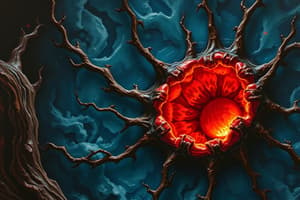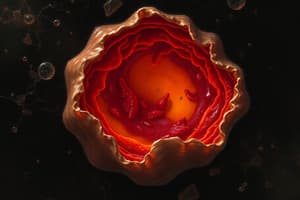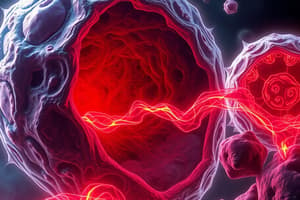Podcast
Questions and Answers
Which of the following is NOT a morphological feature of necrosis?
Which of the following is NOT a morphological feature of necrosis?
- Damage of the cell membrane
- Cell enlargement (swelling)
- Leakage of cell organelles
- Nuclear fragmentation (correct)
What is the main difference between necrosis and apoptosis?
What is the main difference between necrosis and apoptosis?
- Necrosis is a pathological process while apoptosis is a physiological process
- Necrosis involves cell swelling while apoptosis involves cell shrinkage
- Necrosis leads to inflammation while apoptosis does not
- All of the above (correct)
What is the primary trigger that initiates the apoptosis pathway?
What is the primary trigger that initiates the apoptosis pathway?
- Cell membrane damage
- Exposure to radiation
- Viral infection
- Loss of mitochondrial function (correct)
Which of the following is NOT a morphological feature of apoptosis?
Which of the following is NOT a morphological feature of apoptosis?
During which process is apoptosis used to remove excess cells that have no function?
During which process is apoptosis used to remove excess cells that have no function?
Which of the following is a key characteristic of necrosis that distinguishes it from apoptosis?
Which of the following is a key characteristic of necrosis that distinguishes it from apoptosis?
Which of the following is a correct feature of apoptosis?
Which of the following is a correct feature of apoptosis?
What is programmed cell death known as?
What is programmed cell death known as?
Apoptosis is a highly regulated and controlled __ process during an organism’s life.
Apoptosis is a highly regulated and controlled __ process during an organism’s life.
Which process involves phagocytosis of apoptotic bodies with no inflammation?
Which process involves phagocytosis of apoptotic bodies with no inflammation?
In which type of cell death does the cell experience shrinkage and membrane blebbing?
In which type of cell death does the cell experience shrinkage and membrane blebbing?
Which statement accurately describes the effect of apoptosis on surrounding tissues?
Which statement accurately describes the effect of apoptosis on surrounding tissues?
Flashcards are hidden until you start studying
Study Notes
Cell Death
- Cell death is an essential process in the body, promoting the removal of unwanted, harmful cells to maintain tissue homeostasis.
Types of Cell Death
- There are two main types of cell death: Apoptosis and Necrosis.
Necrosis
- Necrosis is an accidental cell death, resulting from pathological processes such as hypoxia, radiation, or pathogens like viruses.
- Morphological features of necrosis include:
- Damage to the cell membrane
- Cell enlargement and swelling
- Cell rupture and leakage of cell organelles
- Nuclear degeneration
- Inflammation with extensive damage to surrounding tissue
Apoptosis
- Apoptosis is a physiological, programmed cell death, controlled by several genes.
- Morphological features of apoptosis include:
- Loss of microvilli and intercellular junctions
- Cell shrinkage and membrane blebbing
- Nuclear fragmentation with hyper condensation of chromatin
- Change of cell membrane characteristics without loss of integrity
- Cell organelles remain apparently normal but become clumped inside the cytoplasm
- Fragmentation of the cell into apoptotic bodies
- Phagocytosis of apoptotic bodies with no inflammation
Physiological Causes of Apoptosis
- During embryonic development, apoptosis removes excess cells that have no function, such as during morphogenesis and for determination of organ size.
- In adult life, apoptosis occurs:
- Hormone-dependent: endometrial shedding during menses, regression of lactating mammary gland after weaning, and regression of prostate in old males.
- Elimination of cells during cell cycle when their DNA damage is not repaired.
- Removal of old cells in highly proliferating organs to maintain a constant number of cells, such as in intestinal epithelium.
Studying That Suits You
Use AI to generate personalized quizzes and flashcards to suit your learning preferences.




